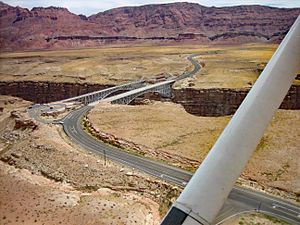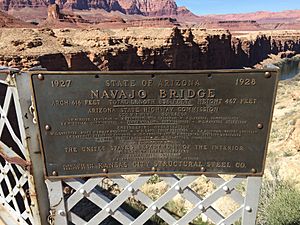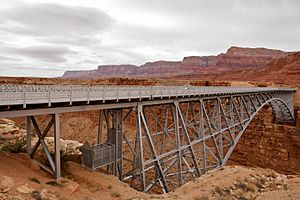Navajo Bridge facts for kids
Quick facts for kids Navajo Bridge |
|
|---|---|

Looking east, with 1929 bridge at left, 1995 bridge at right, and the Echo Cliffs in the background,
May 2006 |
|
| Coordinates | 36°49′2″N 111°37′53″W / 36.81722°N 111.63139°W |
| Carries | |
| Crosses | Colorado River at Marble Canyon |
| Locale | Lees Ferry |
| Official name | Navajo Steel Arch Highway Bridge |
| Other name(s) | Grand Canyon Bridge 1st (originally) Colorado River Bridge 2nd |
| Named for | Navajo people |
| Owner | Arizona Department of Transportation (ADOT) |
| Maintained by | ADOT |
| Heritage status | National Register of Historic Places 1st only |
| ID number | AZ00051 1st AZ02340 2nd |
| Preceded by | Glen Canyon Dam Bridge |
| Followed by | Hoover Dam |
| Characteristics | |
| Design | open-spandrel arch bridge with 90 feet (27 m) rise (both) |
| Material | steel |
| Total length | 834 feet (254 m) 1st 909 feet (277 m) 2nd |
| Width | 18 feet (5.5 m) 1st 44 feet (13 m) 2nd |
| Longest span | 616 feet (188 m) 1st 726 feet (221 m) 2nd |
| Number of spans | 1 (each bridge) |
| Piers in water | 0 |
| Load limit | 22.5 short tons (20.4 t) 1st |
| Clearance below | 467 feet (142 m) 1st 470 feet (140 m) 2nd |
| History | |
| Construction begin | June 1927 (1st) May 1993 (2nd) |
| Construction end | 1929 (1st) 1995 (2nd) |
| Construction cost | $US 390,000 1st $US 14.7 million 2nd |
| Opened | January 12, 1929 (1st) May 2, 1995 (2nd) |
The Navajo Bridge is actually the name for two amazing steel bridges that cross the Colorado River. These bridges are located near Lees Ferry in northern Arizona, United States. They are part of the beautiful Grand Canyon National Park.
The newer of the two bridges carries cars and trucks on U.S. Route 89A. This road helps people travel through Marble Canyon between Bitter Springs and Jacob Lake. It's super important because it connects areas north of the Colorado River, including the North Rim of Grand Canyon National Park.
Before the first Navajo Bridge was built, crossing the Colorado River was very difficult. People used a ferry service at Lees Ferry, which had been running since 1873. But this ferry was not always safe or reliable. Bad weather and floods often stopped it from working.
The first bridge was officially opened on January 12, 1929. It was first called the Grand Canyon Bridge. Five years later, in 1934, its name was changed to Navajo Bridge. When the new bridge opened in 1995, the old one was closed to cars. But you can still walk or ride a horse across it!
Both Navajo Bridges are among the highest bridges in the United States. They are nearly 470 feet (143 meters) above the river. That's taller than a 40-story building!
Contents
How the First Bridge Was Built
Construction on the first Navajo Bridge started in 1927. It was finished and opened to traffic in 1929. The state of Arizona paid for the bridge, working with the U.S. government's Bureau of Indian Affairs. This was because the eastern side of the bridge is on Navajo Nation land.
The Kansas City Structural Steel Company designed and built this steel bridge. Building it was very dangerous work. Sadly, one worker named Lane McDaniel died during construction. He fell 470 feet (143 meters) into the Colorado River. Supervisors had decided not to use safety nets. They worried the nets might catch fire from hot metal pieces falling during construction.
Features of the Original Bridge
The first bridge is 834 feet (254 meters) long. Its highest point is 467 feet (142 meters) above the canyon floor. The road on the bridge is 18 feet (5.5 meters) wide. It could hold up to 22.5 tons. When it was designed, a wider road was considered. But it would have cost too much. Also, cars back then were not as wide as they are today. When the bridge opened in 1929, it was big news for the Southwest!
Why a New Bridge Was Needed
By 1990, many more cars were using the original bridge. Officials realized it was no longer big enough or safe enough. The sharp turns on the roads leading to the bridge made it hard to see other cars. Also, the bridge's width and weight limits were becoming a problem for modern traffic. The bridge had also become part of a major highway, US 89A.
Deciding what to do was tricky. Many groups had different ideas. They worried about protecting sacred Navajo land and rare plants in Marble Canyon. They also wanted to make sure no construction trash fell into the river. At first, they thought about just making the old bridge wider and stronger. But this plan wouldn't meet modern highway safety rules.
So, the only choice was to build a new bridge. They decided to build it right next to the old one. The new bridge would look very similar to the original. But it would be built to modern highway standards. This way, the old bridge could be saved and used for walking.
Building the New Bridge
The Arizona Department of Transportation and the Federal Highway Administration oversaw the building of the new steel arch bridge. It was finished in May 1995. The cost was about $14.7 million. A special opening ceremony was held on September 14, 1995.
Today, the original Navajo Bridge is still open for people to walk or ride horses across. There's even a special center on the west side. It teaches visitors about the bridge's history and how people used to cross the Colorado River. The old bridge is also recognized as a Historic Civil Engineering Landmark. It was added to the National Register of Historic Places in 1981.
Sometimes, you might even see California condors flying near Navajo Bridge. These amazing birds were brought back to the area in 1996.
Bridge Details
The Original Bridge (1929)
- Total length: 834 feet (254 meters)
- Steel arch length: 616 feet (188 meters)
- Arch rise: 90 feet (27 meters)
- Height above river: 467 feet (142 meters)
- Width of the roadway: 18 feet (5.5 meters)
- Amount of steel used: 2,400,000 pounds (1,088,622 kg)
- Amount of concrete used: 500 cubic yards (382 cubic meters)
- Amount of steel reinforcement: 82,000 pounds (37,195 kg)
- Construction cost: $390,000 (which is like $6.8 million today)
The New Bridge (1995)
- Total length: 909 feet (277 meters)
- Steel arch length: 726 feet (221 meters)
- Arch rise: 90 feet (27 meters)
- Height above river: 470 feet (143 meters)
- Width of the roadway: 44 feet (13 meters)
- Amount of steel used: 3,900,000 pounds (1,769,010 kg)
- Amount of concrete used: 1,790 cubic yards (1,368 cubic meters)
- Amount of steel reinforcement: 434,000 pounds (196,850 kg)
- Construction cost: $14.7 million (which is like $29.4 million today)
See also
 In Spanish: Puente Navajo para niños
In Spanish: Puente Navajo para niños





